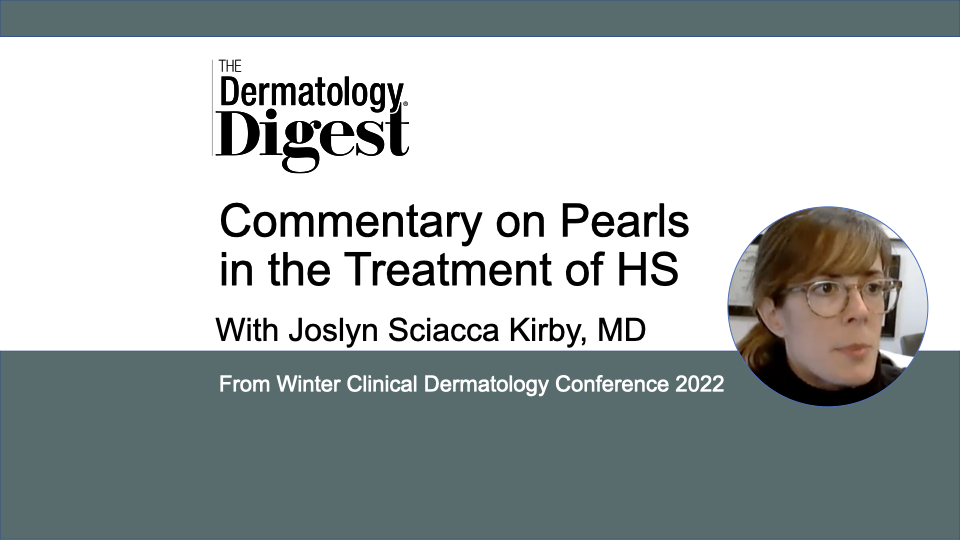Dr. Joslyn Kirby shares 3 pearls derived from pitfalls for treating patients with hidradenitis suppurativa.
Joslyn Sciacca Kirby, MD, Associate Professor of Dermatology, The Pennsylvania State University, Hershey, Pennsylvania
“I tried to focus on three of the things that were actually pitfalls for me… and from those same pitfalls, send people home with a few pearls,” said Joslyn Sciacca Kirby, MD, who presented “Pearls in the Treatment of Hidradenitis Suppurativa” at Winter Clinical Dermatology Conference 2022.
“My first pitfall was not realizing that the flares were controlling my patient and that we weren’t really controlling flares,” said Dr. Kirby.
Recent research shows that most patients with hidradenitis suppurativa (HS) have flares at least once per month, she said.
“So, as we’re thinking about treating HS, recognizing these patients are on a rollercoaster, …it’s my opportunity to help them have fewer flares, shorter flares, or hopefully zero flares.”
In doing so, when flare-directed therapy isn’t working, it’s time to move to a maintenance therapy to preempt those flares, said Dr. Kirby.
“I’ll often combine an anti-inflammatory as well as an antimicrobial together.”
According to Dr. Kirby, that could be oral or topical antibiotics, topical resorcinol or ichthammol, and topical steroids or a short course of systemic prednisone.
“I’ve been really happy with just 50 mg [prednisone] once a day, for as short as five to seven days. I usually don’t need much longer than that.”
Dr. Kirby’s second pitfall was related to a gap in patient education. She found that patients were not starting the biologic therapy she prescribed, which is typically her first line of therapy for those with moderate to severe HS.
“When we explored why, it was because either the patient or their primary care provider had the misconception that they were getting infections repeatedly and that their immune system didn’t work, when, in fact, all the things that the patient or their provider thought were infections were really inflammatory flares of the HS.”
According to Dr. Kirby, the key to preventing this misconception is proactively explaining to the patient that an overactive immune system is causing the HS flares.
“We need to use medicines like the biologics to bring it back down towards normal.”
Dr. Kirby said she asks patients two questions to help them make their own decision about beginning treatment: one is about the frequency of flares and the other is duration.
“A lot of the research support for [frequency] is anywhere from 7 to 14 days, so I do some math right there in the room with a patient. I’ll say, okay, it sounds like once a month for 10 days—that’s 10 days of every 30 days. That’s a third of your month. That’s a third of your year. It’s a third of your recent life. Is it worth it to you to either take a pill every day or take a shot [every] so often in order to try and get a better control over the HS? And that’s just the jumping off point of the conversation.”
The third pitfall and pearl are related to surgical procedures for tunneling and persistent lesions. While Dr. Kirby admitted she initially undervalued these during the early years of her career, they have become a cornerstone of HS treatment.
“[We] don’t have a medicine in our hands right now that will get rid of the tunnels and some of these persistent lesions.”
To determine whether patients may need a surgical procedure, Dr. Kirby said she asks patients two questions:
“I think the most valuable question we can ask is, are you noticing that spots move around? If that’s the case, then we need to adjust medicines.”
The second question is, do the spots come back or stay active in the same place?
“Those kinds of persistent lesions are sometimes tunnels or just pockets of HS inflammation that need a procedure.”
Dr. Kirby’s preferred approach for persistent lesions is deroofing, a fast and effective electrosurgery procedure that removes the lesion “roof.”
But, she cautioned, success using these kinds of procedures requires time and strategic progression.
“I started in the under arm, and now I’m moving on to lesions on the scrotum and in the groin and on the buttocks,” said Dr. Kirby.
Overall, “It makes a huge difference to use all the tools that we have as dermatologists, which is knowing the medicines but also being able to do the procedures and just combining those things together for people with HS.”

